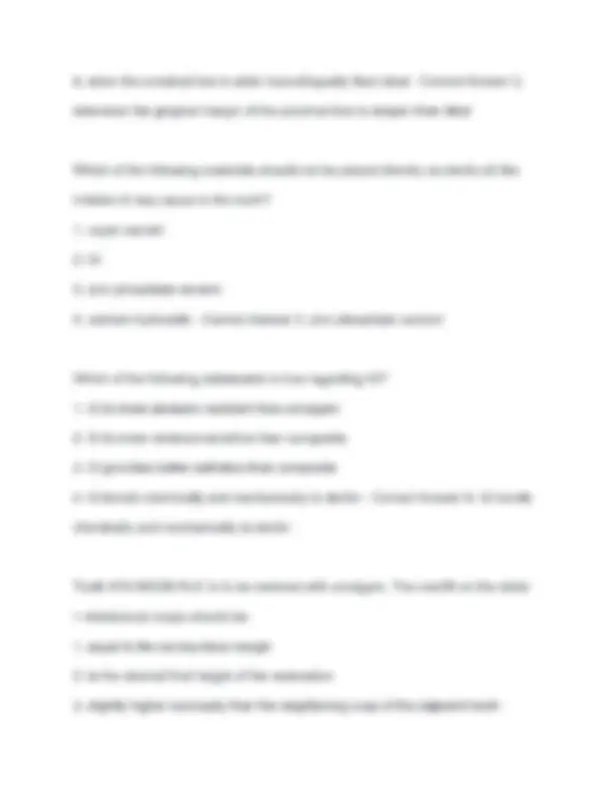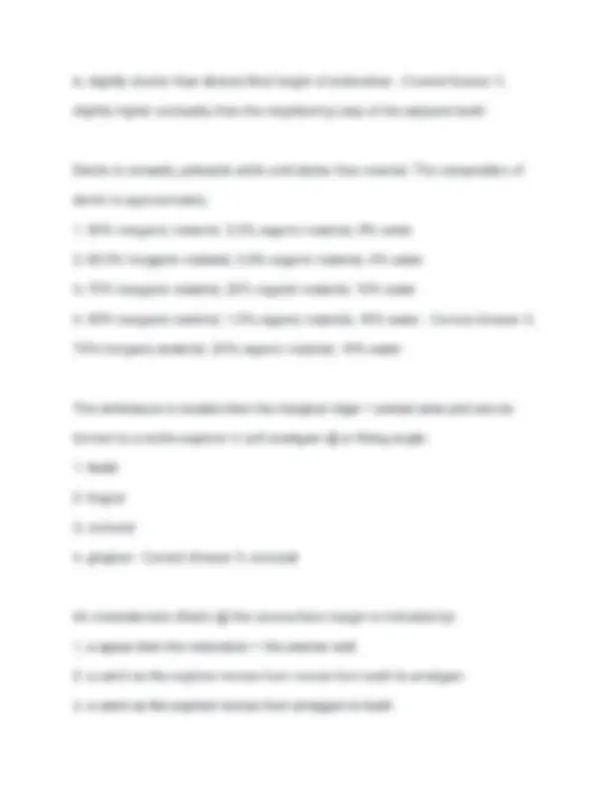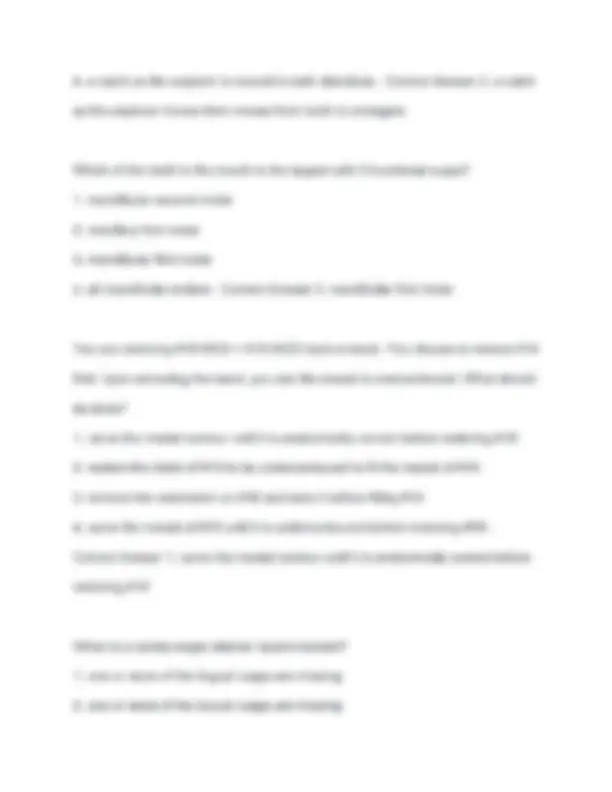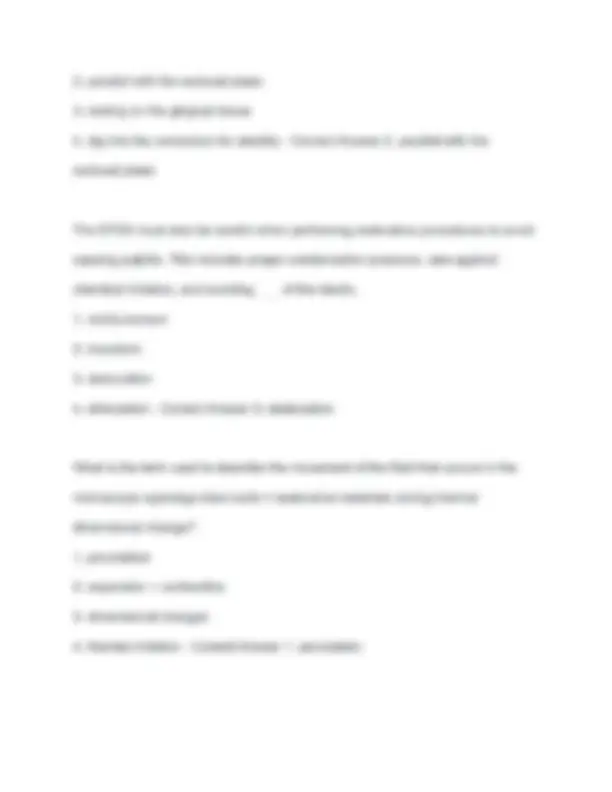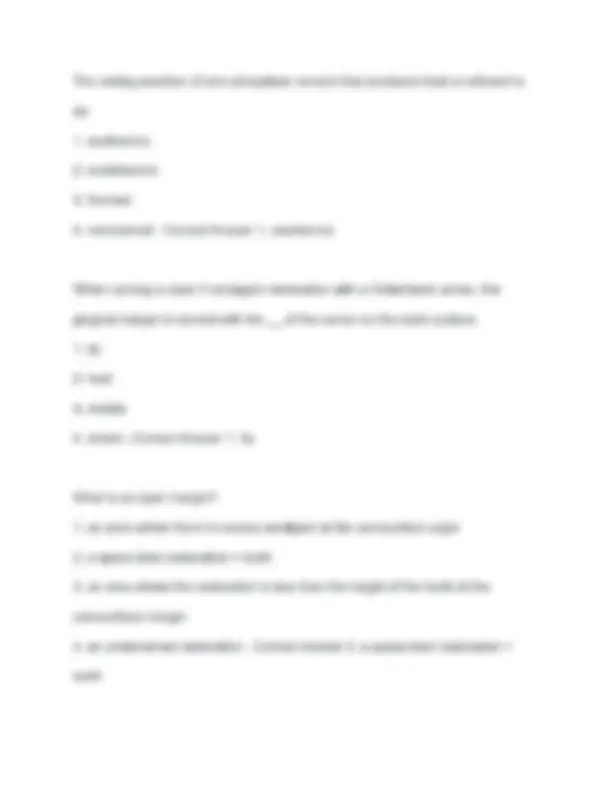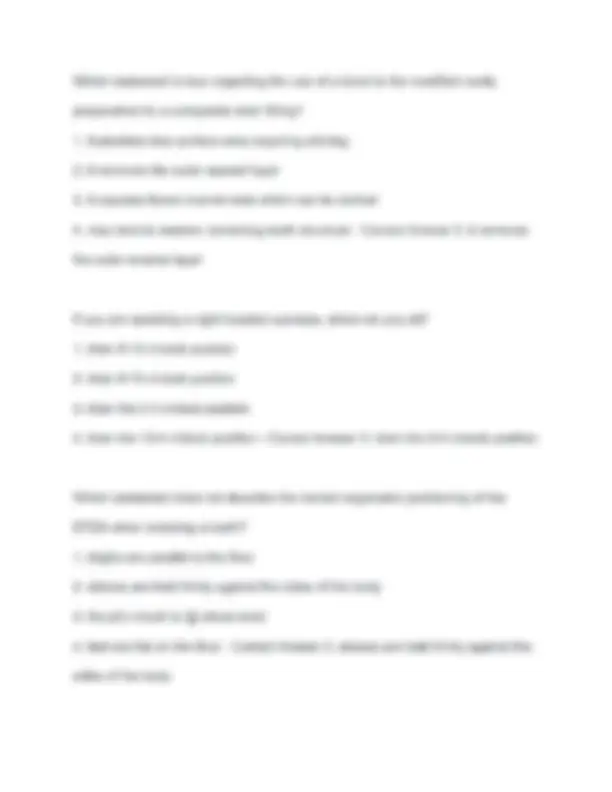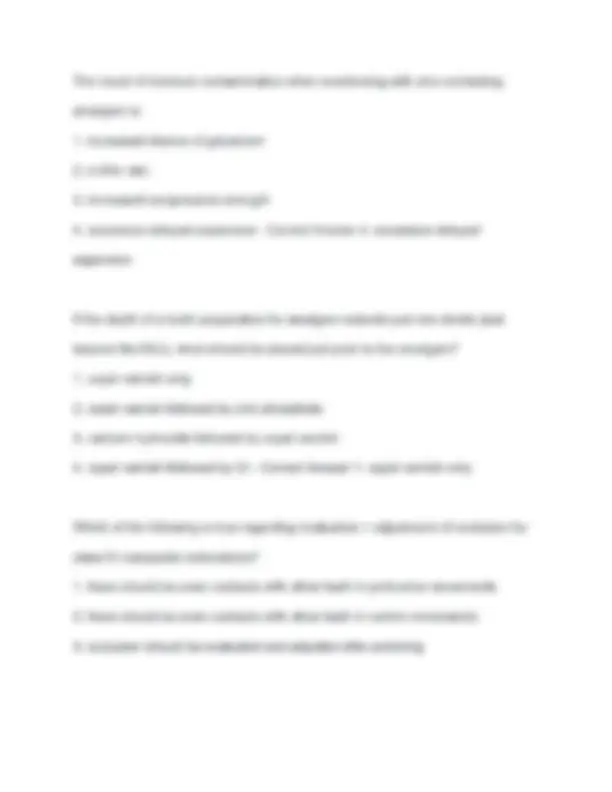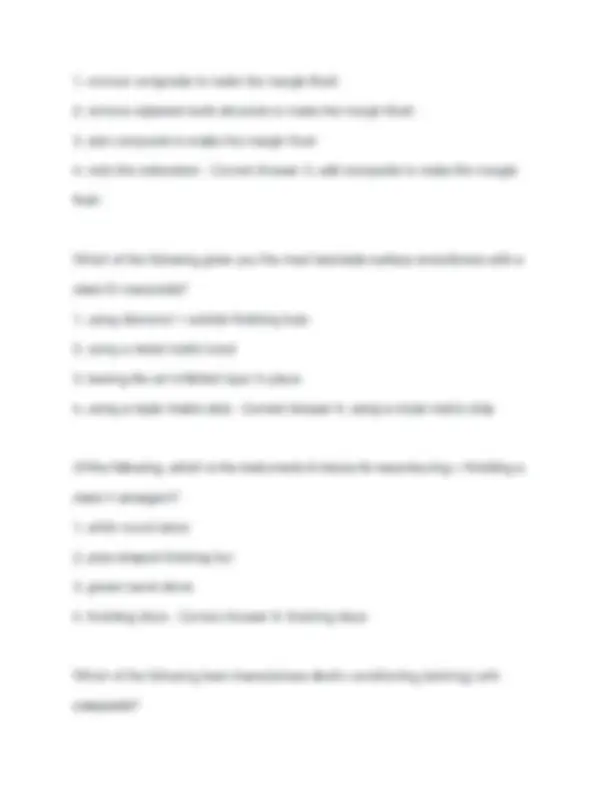Partial preview of the text
Download EFDA Review Practice Exam| Questions With Verified Solutions 2025/2026 and more Exams Dentistry in PDF only on Docsity!
Basic remediable intraoral tasks and/or procedures include all of the following except: 1. impressions for diagnostic models or mouthguard 2. suture removal 3. placement of gingival retraction cord prior to direction impression 4. placement of surgical dressings - Correct Answer 3. placement of gingival retraction cord prior to direction impression The following statements all apply to direct supervision except: 1. dentist is physically present during the performance of delegated "acts" 2. dentist checks the pt before pt leaves the office 3. dentist is personally operating on a pt 4. delegated procedures are performed pursuant to dentist's order and under his/her license - Correct Answer 3. dentist is personally operating on a pt The following statements are true regarding the dental pulp except one. Which one is the exception? 1. provides nutrients + fluids to the dentin thru the blood supply 2. contains nerve fibers that mediate pain sensations 3. contains odontoblasts which help form primary, secondary, and reparative dentin 4. increases in size with age - Correct Answer 4. increases in size with age On a tooth with extensive gingival recession below the CEJ, which of the following would be visible? 1. anatomical crown 2. clinical crown 3. anatomical + clinical crown 4. anatomical + clinical root - Correct Answer 3. anatomical + clinical crown Which of the following statements most accurately describes the periodontium? 1. the oral hard + soft tissues that support the teeth 2. enamel + cementum located on the exterior surfaces of the teeth 3. soft tissue that is loosely attached to the underlying bone 4. cuff of tissue that is not attached to the tooth - Correct Answer 1. the oral hard + soft tissues that support the teeth When would an open sandwich technique with GI be recommended? 1. whenever a metal matrix band is used 2. whenever the gingival margin of the proximal box is deeper than ideal 3. it is recommended with every class II composite restoration 4. slightly shorter than desired final height of restoration - Correct Answer 3. slightly higher occlusally than the neighboring cusp of the adjacent tooth Dentin is normally yellowish-white and darker than enamel. The composition of dentin is approximately: 1. 90% inorganic material, 2.0% organic material, 8% water 2. 95.5% inorganic material, 0.5% organic material, 4% water 3. 70% inorganic material, 20% organic material, 10% water 4. 85% inorganic material, 1.0% organic material, 10% water - Correct Answer 3. 70% inorganic material, 20% organic material, 10% water This embrasure is located btwn the marginal ridge + contact area and can be formed by a sickle explorer in soft amalgam @ a 45deg angle: 1. facial 2. lingual 3. occlusal 4. gingival - Correct Answer 3. occlusal An overextension (flash) @ the cavosurface margin is indicated by: 1. a space btwn the restoration + the enamel wall 2. a catch as the explorer moves from moves from tooth to amalgam 3. a catch as the explorer moves from amalgam to tooth 4. a catch as the explorer is moved in both directions - Correct Answer 2. a catch as the explorer moves from moves from tooth to amalgam Which of the teeth in the mouth is the largest with 5 functional cusps? 1. mandibular second molar 2. maxillary first molar 3. mandibular first molar 4. all mandibular molars - Correct Answer 3. mandibular first molar You are restoring #18 MOD + #19 MOD back-to-back. You choose to restore #18 first. Upon removing the band, you see the mesial is overcontoured. What should be done? 1. carve the mesial contour until it is anatomically correct before restoring #19 2. restore the distal of #19 to be undercontoured to fit the mesial of #18 3. remove the restoration on #18 and redo it before filling #19 4. carve the mesial of #18 until it is undercontoured before restoring #19 - Correct Answer 1. carve the mesial contour until it is anatomically correct before restoring #19 When is a contra-angle retainer recommended? 1. one or more of the lingual cusps are missing 2. one or more of the buccal cusps are missing 4. wipe or rinse the abrasive residue off of the tooth when changing discs - Correct Answer 4. wipe or rinse the abrasive residue off of the tooth when changing discs When posterior teeth are viewed from the occlusal, the proximal contacts are usually located: 1. more lingual in a buccal to lingual direction 2. more distal in a mesial to distal direction 3. more mesial in a mesial to distal direction 4, more buccal in a buccal to lingual direction - Correct Answer 4. more buccal in a buccal to lingual direction Where are the points of the jaw positioned on a properly placed rubber dam clamp? 1. at the CEJ 2. at the DEJ 3. apical to the CEJ 4. apical to the DEJ - Correct Answer 1. at the CEJ The points of the jaws of the gingival retractor such as the anterior #212 clamp should be: 1. parallel with the long axis of the tooth 2. parallel with the occlusal plane 3. resting on the gingival tissue 4. dig into the cementum for stability - Correct Answer 2. parallel with the occlusal plane The EFDA must also be careful when performing restorative procedures to avoid causing pulpitis. This includes proper condensation pressure, care against chemical irritation, and avoiding __ of the dentin. 1. reinforcement 2. insulation 3. desiccation 4. stimulation - Correct Answer 3. desiccation What is the term used to describe the movement of the fluid that occurs in the microscopic openings btwn tooth + restorative materials during thermal dimensional change? 1. percolation 2. expansion + contraction 3. dimensional changes 4. thermal irritation - Correct Answer 1. percolation Which statement is true regarding the use of a bevel in the modified cavity preparation for a composite resin filling? 1. it provides less surface area requiring etching 2. it removes the outer enamel layer 3. it exposes fewer enamel rods which can be etched 4. may tend to weaken remaining tooth structure - Correct Answer 2. it removes the outer enamel layer If you are assisting a right-handed operator, where do you sit? 1. btwn 8-12 o'clock position 2. btwn 8-10 o'clock position 3. btwn the 2-4 o'clock position 4. btwn the 12-4 o'clock position - Correct Answer 3. btwn the 2-4 o'clock position Which statement does not describe the correct ergonomic positioning of the EFDA when restoring a tooth? 1. thighs are parallel to the floor 2. elbows are held firmly against the sides of the body 3. the pt's mouth is @ elbow level 4. feet are flat on the floor - Correct Answer 2. elbows are held firmly against the sides of the body When restoring a small class III restoration with composite on tooth #23 distolingual, what is done immediately after the acid etchant is placed for 15 seconds? 1. select shade 2. rinse with a gentle stream of water 3. place a mylar strip btwn #22 + #23 4. dry the tooth until it has a frosted appearance - Correct Answer 2. rinse with a gentle stream of water Regarding the placement of a large class IV composite restoration, which statement is true? 1. the curing wand should be close enough to touch the restoration 2. this composite restoration should be cured only from the lingual 3. if applying a second layer of composite, remove the air inhibited layer first 4. if the tooth is contaminated with saliva, clean by etching for 10-15 seconds, rinse, dry, and proceed - Correct Answer 4. if the tooth is contaminated with saliva, clean by etching for 10-15 seconds, rinse, dry, and proceed Which of the following statements describe the desired occlusion when restoring aclass Il amalgam? 1. premature contacts occur, but only in centric occlusion 2. the amalgam is just slightly out of occlusion The result of moisture contamination when condensing with zinc-containing amalgam is: 1. increased chance of galvanism 2. a drier mix 3. increased compressive strength 4. excessive delayed expansion - Correct Answer 4. excessive delayed expansion If the depth of a tooth preparation for amalgam extends just into dentin (just beyond the DEJ), what should be placed just prior to the amalgam? 1. copal varnish only 2. copal varnish followed by zinc phosphate 3. calcium hydroxide followed by copal varnish 4. copal varnish followed by GI - Correct Answer 1. copal varnish only Which of the following is true regarding evaluation + adjustment of occlusion for class IV composite restorations? 1. there should be even contacts with other teeth in protrusive movements 2. there should be even contacts with other teeth in centric movements 3. occlusion should be evaluated and adjusted after polishing 4. occlusion should be evaluated + adjusted after finishing, but before polishing - Correct Answer 4. occlusion should be evaluated + adjusted after finishing, but before polishing What is true about a modified preparation for an anterior composite restoration? 1. the prepared walls form a 90deg angle with the uncut tooth 2. the prepared walls form a 45deg bevel with the uncut tooth 3. the bevel reduces the # of rods for enamel etching and retention 4. the 90deg bevel provides an esthetic blending from unprepared tooth to restoration - Correct Answer 2. the prepared walls form a 45deg bevel with the uncut tooth Which of the following line angles is present in the class II mesio-occlusal cavity preparation but not in a class | occlusal cavity preparation? 1. pulpo-buccal 2. linguo-pulpal 3. occluso-pulpal 4. axio-pulpal - Correct Answer 4. axio-pulpal The gingival margin of a very large class V composite preparation ends on the anatomic root surface. Upon final evaluation, the gingival margin is submarginal by less than .2mm. What should you do? 1. itis an optional step for dental adhesion 2. improves mechanical retention by eliminating or modifying the smear layer 3. lowers the bond strength 4. creates a chemical bone - Correct Answer 2. improves mechanical retention by eliminating or modifying the smear layer What is a common composition of the alloy powder of amalgam? 1. mercury, silver, tin, copper, zinc 2. mercury, silver, copper, zinc 3. aluminum, silver, tin, zinc 4. silver, tin, copper, zinc - Correct Answer 4. silver, tin, copper, zinc How will adequate condensation pressure strengthen the final restoration? 1. by eliminating voids + reducing excess mercury 2. by reducing excess mercury only 3. by decreasing the contraction 4. by increasing expansion - Correct Answer 1. by eliminating voids + reducing excess mercury What is one function of a properly positioned wedge? 1. restore proximal contours 2. to create retention of the restoration 3. adaptation of the matrix band to the tooth to prevent overhangs 4. to create a missing wall for restorative material - Correct Answer 3. adaptation of the matrix band to the tooth to prevent overhangs What could result if the EFDA placed a matrix band too snugly around a tooth with a class II preparation for an amalgam restoration? 1. overhangs 2. voids in the proximal box 3. open or light contact areas 4, amalgam expansion - Correct Answer 3. open or light contact areas What can happen if one failed to condense amalgam into the mechanical retentive features of a restoration? 1. flash 2. overextension of amalgam 3. submarginal area 4. weakened retention of the restoration - Correct Answer 4. weakened retention of the restoration An undercontoured class V restoration: 1. will displace the gingival from its normal position 2. is caused by not removing enough of the restorative material 
